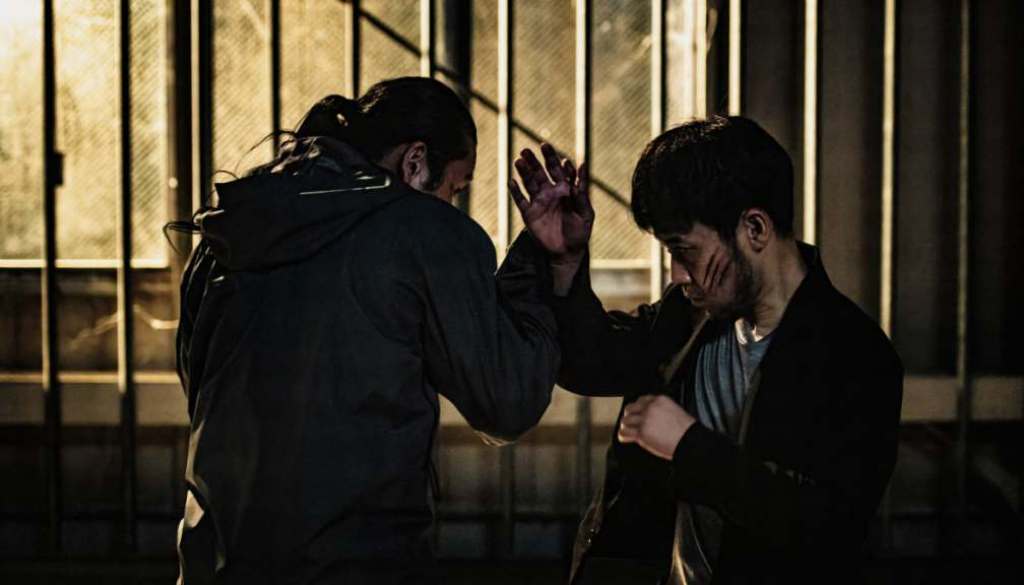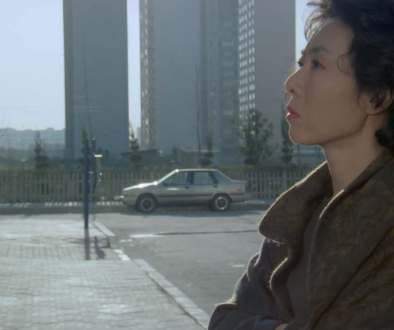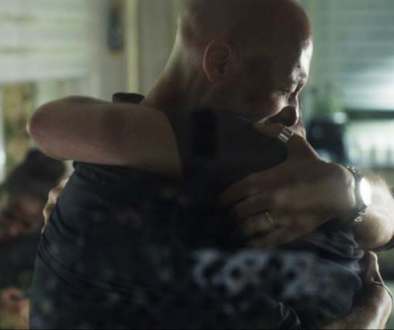Fantastic Fest XVIII Review: In ONE-PERCENTER, Tak Sakaguchi Demonstrates The Method To The Madness!
“There are many martial artists in the world. Only one in every hundred master their art. Those are the ‘One-Percenters.'”
…That’s a line spoken in the international trailer and newest incumbent feature from writer/director Yudai Yamaguchi, a man imbued with a wealth of knowledge and experience when it comes to working with actor and genre cinema favorite, Tak Sakaguchi.
The pair have done various types of movies together, with Sakaguchi in roles that have seen him merc the undead, partake in explosive baseball battles, and even wipe out henchmen as a bionically-weaponized gangster, among other projects the two have collaborated on with other directors. It would be in 2005 that fans of Sakaguchi would see the actor embark a little more on his own quest into action direction, clearly looking to up his station in the craft following the success he gained from his previous credits. Alas, after more than two decades in film and television, it finally feels as if Sakaguchi has reach a more definitive pinnacle in the action arena.
Yuji Shimomura’s 2016 sophomore outing, Re:Born, would result in Sakaguchi’s expeditious comeback from retirement a few years earlier, teaming him up with Yoshitaka Inagawa and using his Zero Range Combat system as a fitting tool to bolster his own WAVE study for screenfighting. And you know what? It worked. It worked so well that seven years later and with a little more work and some patience, Sakaguchi and Inagawa did it again, joining Yamaguchi, and even bringing action specialist Kensuke Sonomura of Hydra, Bad City, and Yugo Sakamoto’s Baby Assassins fame in the mix. You might even agree that there is a certain admirability when you can take real-world aspects of your own career and use them to craft a fictionalized version of yourself, teetering enough on the edge of fantasy and reality so as to keep your audience guessing and enticed accordingly.
Thus, we get One-Percenter, commencing a story that introduces us to Toshiro Takuma (Sakaguchi), an action actor and the deviser of “Assassination-Jutsu” who rose to fame ten years earlier with the success of his last film, “Birth.” Nevertheless, Takuma is struggling with standards of action and stunt performance as imposed by the crew. He typically stands jaded by his environment on set, painstakingly waiting for someone to call cut as he toils through choreography. Moreover, he can’t stomach finicky directors like Tony (Taro Suruga), or working with posers who can’t do action, and the same goes for many familiar with his growing reputation. Unfortunately, that also goes for the only other two mentees in his corner who’ve all but cut ties with Takuma, leaving only the meek but enthusiastic Akira (Kohei Fukuyama) to help pick up the slack.
Of course for Takuma, this is hardly a setback. He has a dream that’s been cooking on the back of his brain for a decade: the chance to make a 100% pure action film. With a little help and some hustling to get pre-production going, he and Akira manage to stakeout a two year-old factory on a remote island to make their movie. Nevermind that they’ve stumbled upon a few of Takuma’s old mutuals doing a clownish wuxia pre-viz for some major studio picture, although as the group come to realize within a matter of minutes amid all the chatter, a little competiton in action moviemaking amongst one another will be the least of their worries.
A stray bullet suddenly enters the conversation by way of someone’s head, moments before a drone shot reveals the distance between our unarmed cohorts and two groups of rival yakuza gangs in the middle of a shootout. One is led by boss Takenouchi (Sho Aoyagi) who has taken an innocent young woman named Maria (Rumika Fukuda) hostage. He, as well as his pursuants, Shishidou (Norihisa Hiranuma) and his sadistic one-legged daughter, Ami (Kanon Narumi), are both in search of a hidden cache containing tons of drugs stashed away by Maria’s father. With the factory now turned into an explosive battleground between real-life criminals and nearly all of Takuma’s former colleagues in the wind, the struggling action film purveyor takes advantage of his latest golden opportunity to turn this deadly drug raid into unfiltered, unvarnished, history-making action cinema.
The most fascinating part of this setup until midway into the film is that Shishidou and his men literally have no idea what they’re in for. Any speculation draws them to believe that the mysterious man using their own communication equipment to egg them on is on a mission of his own to thwart them. At this juncture, nobody knows what Takuma looks like or has even seen him, but it’s after a bit of repartee with Shishidou that Takuma responds to Ami’s inquiry about who he is and his purpose there, implying that he has to keep his fans happy. The bewildering moment only adds to the momentous tone and excitment that follows as Takuma moves in on all of the tactically-armed yakuzas. A self-stylized expert by any measure just short of choosing to kill anyone, Takuma takes the mantle with Akira at the lens of his trusty smartphone, and commences singlehandedly taking on the armed tactical units working for the yakuzas.
The biggest twist is yet to come in Yamaguchi’s 80+ minute action thriller. For the rest of the movie leading up until then, it’s a fun little escape into some of the best fan-service we’ve seen from Sakaguchi in years, with just a little wiggle room for comedy relief. The imagery and footage in the inaugural five-minute featurette into Takuma’s life and career speaks well to this aspect, and even with regard to the title treatment on the movie-in-a-movie poster for Takuma’s “Birth,” which looks absolutely like a nod to a certain freshman action horror that cast Sakaguchi into global indie stardom back in 2000.
The bigger star of the film, of course, is the one that permeates around Takuma – one shrouded in mystery as we learn more about his motivations, and the resilient loyalty he has from Akira. The writing and execution of the performances by Sakaguchi and co-star Fukuyama will leave you intrigued by Yamaguchi’s keenness for detail and applied vagueries, and in ample gratitude that a production like this keeps such a tight lid on its innerworkings. Take it all at face value – or not – as the film advances between every development and revelation from our characters, and the fisticuffs aplenty that fill in the gaps.
I’ve talked at least once about Hiranuma in the past pertaining to at least one of his two directorial works, namely with 2019’s DTC Yukemuri Junjo hen From High & Low, an effervescent breakaway from the requisite action and brooding seen in the High & Low saga. He’s had a few stints on screen as well, and so I think One-Percenter makes for a neat little into into his craft by fans who are curious, and if there’s any question as to whether he nails the part of the sneering, brash and bloodthirsty Shishidou, trust me. He does. Lending further credence to the antagonism is Narumi’s role of Ami whose menacing and immediate brutality extends only as far as any hidden weapons she can wield in her crippled state. That includes (and is most certainly limited to) Ami’s elite enforcer who she calls “Sensei,” played fashionably by Jeet Kune Do and Jun Fan Gung Fu expert, Togo Ishii.
Broken bones and crippling blows to key parts of the body are par for the course in Sonomura’s action direction, which carries something special in its current shelf life. The last fifteen years have surfaced an audible conversation among action fans on how action should be shot and filmed, with comparative discussions measured between industries in Hong Kong and throughout Asia and South India. The term “Bourne-style” comes to mind as the reference to the kind of action that spawned in the sequels that began with The Bourne Identity and Taken, as well as in films like Safe House or some of the Daniel Craig-led 007 installments. Even Korean titles like The Suspect and Chang’s The Target have lended themselves as examples on either side of the debate on the do’s and don’ts of action cinema, specifically involving close-quarters choreography, which makes it all the more pleasing that Sonomura and his ilk have done way with the needless frills of action design to flesh out good cinematic fight scenery. Stylistically, it’s a continuation of everything fans loved about the action in Re:Born, between Sakaguchi’s one-man army sequences and all right down to his one-on-one dance to the death with Ishii.

There’s at least one underlying theme in the film’s fan service that sort of takes a life of its own, leading up to the action finale between Sakaguchi and Ishii. It’s a humoring little addendum to the context pertinent to Sakaguchi’s character and world overall, with a little something extra toward Ishii that martial arts movie fans will appreciate. The larger picture, however, is shrouded in mystery which compels you to keep watching, even when you think you have all the pieces put together; There’s a moment where Takuma is talking to Akira about their planned movie and how even good action is like a drama itself. Later on during the siege, Takuma’s fight in a small dark room with a squad of yakuzas is encapsulated in part with a piano interlude of Johann Debussy’s “Clair de Lune” to sprinkle a bit of visual intrigue on said “dramatizing.” It almost makes you wonder if you’re seeing the sequence as shot in Takuma’s eyes, even as Akira is somewhere at a distance holding the camera – if that.
Blindly, I still hang on to the hopes of seeing an actual feature continuation of Ryuhei Kitamura’s Versus, whether its in direct or legacy form with a new cast, crew and storyline. I always come back to Versus as it marked the beginnings of an era of fandom I never really knew existed until college, followed by my subsequent wandering into a Suncoast DVD store. It’s certainly a film that I can appreciate as the first of the many building blocks that Sakaguchi has accrued over the years to improve his craft. His circle of friends and cohorts in martial arts and military combatives, stunts and film have lended extraordinarily to the action star he’s become today, which makes One-Percenter a brutal, kinetic screenfighting spectacle worthy of praise.
Sakaguchi’s Takuma comes comprised with a combination of samurai and martial philosophy that bolsters the film’s dark, scintillating psychological twist to a point that will have you assessing nods to any film comparisons you might be minding at the moment. I’m thinking somewhere along the lines of David Fincher and a bit of Musashi lore, and not for nothing with respect to the latter. Sakaguchi’s last starrer in Crazy Samurai Musashi was a bold experiment in one-take action that sat for years on the shelf before it was finally completed and released to festivals. It was definitely something different for Tak as an actor – which is believably crucial for any artist to do – even if it didn’t go over well with every film critic. For what it’s worth, it certainly gave insight into Sakaguchi’s concatenation as an action star figure in movies, allowing for a film like One-Percenter to transpire, and add another layer of creative depth that I believe will fascinate anyone who has followed his career up to this point.
Yamaguchi’s direction, coupled with Kensuke Sonomura’s thrilling action design to bolster Tak’s signature style makes One-Percenter another keeper. If you loved Versus or Battlefield Baseball, and if Yuji Shimomura’s Death Trance and Re:Born and have been waiting for an encore in a similar vein with the latter, One-Percenter is a film that will leave you among like minds in the proud majority.
Screened for Fantastic Fest.
Native New Yorker. Been writing for a long time now, and I enjoy what I do. Be nice to me!






ONE PERCENT WARRIOR: Tak Sakaguchi Unrelents In The Official U.S. Trailer! | Film Combat Syndicate
February 1, 2024 @ 8:19 pm
[…] brand of cinematic action these days – will take a liking to Yamaguchi’s new flick. As I iterated in my Fantastic Fest review last year, there’s a subtle psychological nod akin to the likes of David Fincher that makes this film […]